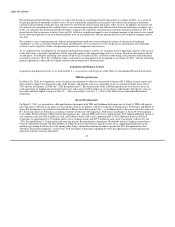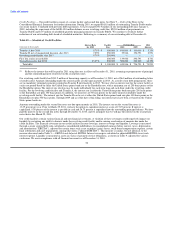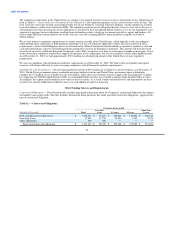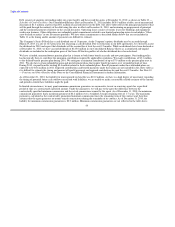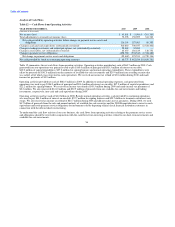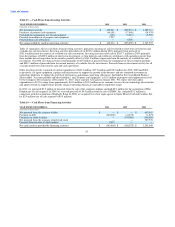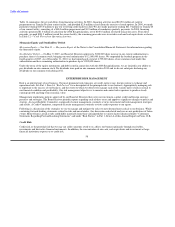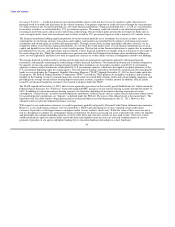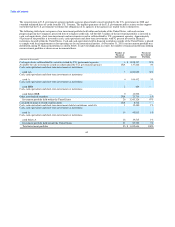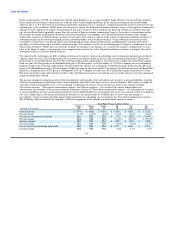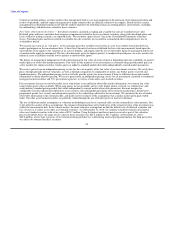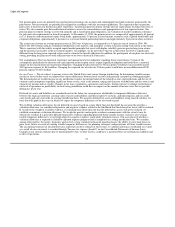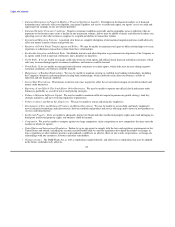MoneyGram 2010 Annual Report Download - page 62
Download and view the complete annual report
Please find page 62 of the 2010 MoneyGram annual report below. You can navigate through the pages in the report by either clicking on the pages listed below, or by using the keyword search tool below to find specific information within the annual report.
Table of Contents
Investment Portfolio — Credit risk from our investment portfolio relates to the risk that we may be unable to collect the interest or
principal owed to us under the legal terms of the various securities. Our primary exposure to credit risk arises through the concentration
of a large amount of our investment portfolio at a few large financial institutions ("financial institution risk"), as well as a concentration
in securities issued by, or collateralized by, U.S. government agencies. We manage credit risk related to our investment portfolio by
investing in short-term assets and in issuers with strong credit ratings. Our investment policy permits the investment of funds only in
cash, cash equivalents, short-term investments and securities issued by U.S. government agencies with a maturity of 13 months or less.
The financial institutions holding significant portions of our investment portfolio act as custodians for our asset accounts, serve as
counterparties to our foreign currency transactions and conduct cash transfers on our behalf for the purpose of clearing our payment
instruments and related agent receivables and agent payables. Through certain check clearing agreements and other contracts, we are
required to utilize several of these financial institutions. As a result of the credit market crisis, several financial institutions have faced
capital and liquidity issues that led them to restrict credit exposure. This has led certain financial institutions to require that we maintain
pre-defined levels of cash, cash equivalents and investments at these financial institutions overnight, with no restrictions to our usage of
the assets during the day. While the credit market crisis and recession affected all financial institutions, those institutions holding our
assets are well capitalized, and there have been no significant concerns as to their ability to honor all obligations related to our holdings.
We manage financial institution risk by entering into clearing and cash management agreements primarily with major financial
institutions, and regularly monitoring the credit ratings of these financial institutions. Our financial institution risk is further mitigated as
the majority of our cash equivalents and investments held by these institutions are invested in securities issued by U.S. government
agencies or money market instruments collateralized by U.S. government agencies, which have the implicit or explicit guarantee of the
U.S. government depending upon the issuing agency. Our non-interest bearing cash held at our domestic clearing and cash management
banks was covered under the Temporary Liquidity Guarantee Program ("TLGP") through December 31, 2010 as those banks opted into
the program. The Federal Deposit Insurance Corporation ("FDIC") created the TLGP program to strengthen confidence and encourage
liquidity in the banking system by guaranteeing newly issued senior unsecured debt of banks, thrifts and certain holding companies, and
providing full coverage of non-interest bearing deposit transaction accounts, regardless of dollar amount. In addition, official checks
issued by our financial institution customers were treated as deposits under the TLGP.
The TLGP expired on December 31, 2010, but has been replaced by provisions in the recently passed Dodd-Frank Act, which amend the
Federal Deposit Insurance Act ("FDI Act") to provide unlimited FDIC insurance on non-interest bearing accounts through December 31,
2012. In addition to cash in non-interest bearing accounts, the final rule's definition of non-interest bearing transaction accounts
encompasses "official checks" issued by insured depository institutions. Official checks, such as cashier checks and money orders issued
by insured depository institutions, are "deposits" as defined under the FDI Act. The payee of the official check is the insured party. The
legislation will also allow banks to begin paying interest on demand deposit accounts beginning on July 21, 2011. However, this
alternative does not provide unlimited insurance coverage.
With respect to our credit union customers, our credit exposure is partially mitigated by National Credit Union Administration insurance.
However, as our credit union customers were not insured by a TLGP-equivalent program, we have required certain credit union
customers to provide us with larger balances on deposit and/or to issue cashier's checks only. While the value of these assets are not at
risk in a disruption or collapse of a counterparty financial institution, the delay in accessing our assets could adversely affect our liquidity
and potentially our earnings depending upon the severity of the delay and corrective actions we may need to take. Corrective actions
could include draws upon our senior facility to provide short-term liquidity until our assets are released, reimbursements of costs or
payment of penalties to our agents and higher banking fees to transition banking relationships in a short timeframe.
59


